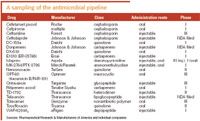Wanted: Superdrugs for superbugs
While drug-resistant infections have been multiplying, there has been a mere trickle of new antibiotics coming down the pipeline. The tide may be changing; there are 30 or more antibiotics in development.

However, the tide may be changing. There are 30 or more antibiotics in development. Unfortunately, it might not be changing quite as fast as is needed. Several of these drugs are currently marketed antibiotics seeking new indications. Others are new members of established classes, such as the fluoroquinolones or the cephalosporins.

First up is a new class of antibiotics, the lipoglycopeptides. These drugs are the closest to reaching the market and have received their share of attention. The hype may be warranted, according to Schwiesow. The drugs have a dual mechanism of action: they kill gram-positive bacteria by inhibiting the formation of bacterial cell walls and disrupting cell membrane formation. In theory, this dual action results in quick efficacy and may prevent the development of resistance and cross-resistance with other drugs.
In clinical studies, the lipoglycopeptides have been active against both methicillin-resistant Staphylococcus aureus (MRSA) and vancomycin-resistant S. aureus (VRSA). They look good, but it should be noted they're closely related to vancomycin, a glycopeptide. Despite vancomycin's multiple mechanisms of action, bacteria have managed to develop resistance to it. Time will tell whether bacteria are also successful in developing resistance to the lipoglycopeptides.
Dalbavancin (Zeven) is Pfizer's lipoglycopeptide candidate. The drug only has to be administered once weekly, and two doses would complete treatment for skin infections. Pfizer is awaiting approval of the drug for the treatment of complicated skin and soft tissue infections.
Telavancin is the lipoglycopeptide discovered by Theravance. The firm submitted a New Drug Application (NDA) in December and is awaiting Food & Drug Administration approval for the antibiotic. Schwiesow noted one study illustrating telavancin's ability to penetrate the lungs and wondered whether the drug might be effective for pneumonia caused by gram-positive organisms. Other drugs, such as daptomycin (Cubicin, Cubist), approved for MRSA, are not approved for pneumonia. "Perhaps [telavancin] can do what daptomycin cannot?" he wondered.
Theravance isn't relying solely on telavancin in the search for a superdrug. The company's other candidate is TD 1792. This antibiotic also has a dual mechanism of action, working like both the glycopeptides and the beta-lactams. Like telavancin, TD 1792 is for gram-positive infections. However, it has further to travel before approval-TD 1792 is still in phase I trials.
Another new class of antibiotics is the aminomethylcyclines (AMCs). Derived from the tetracyclines, this class has the potential to treat infections caused by a wide variety of bugs. One AMC, MK-2764/PTK 0796, is being codeveloped by Merck and Paratek. The drug has exhibited activity against gram-positive, gram-negative, atypical, and anaerobic bacteria, including resistant strains. It is currently in phase I trials.